Strategic Review Report: Nestlé (MGT 30625) Analysis, Year III, ICASL
VerifiedAdded on 2021/08/04
|18
|5541
|216
Report
AI Summary
This strategic review report provides an in-depth analysis of Nestlé S.A., examining its internal capabilities and external environment. The report utilizes the Resource-Based View (RBV) and value chain models to assess Nestlé's internal strengths and weaknesses, including threshold and unique capabilities, resources, and core competencies. The analysis extends to the external environment using the PESTDN model to evaluate political, economic, socio-cultural, technological, demographic, and natural factors. Furthermore, the report applies Porter's Five Forces model to analyze the industry's competitive dynamics, including the threat of new entrants, substitutes, competitive rivalry, and the bargaining power of buyers and suppliers. The report concludes with a comprehensive overview of Nestlé's strategic position and recommendations based on the analyses conducted.
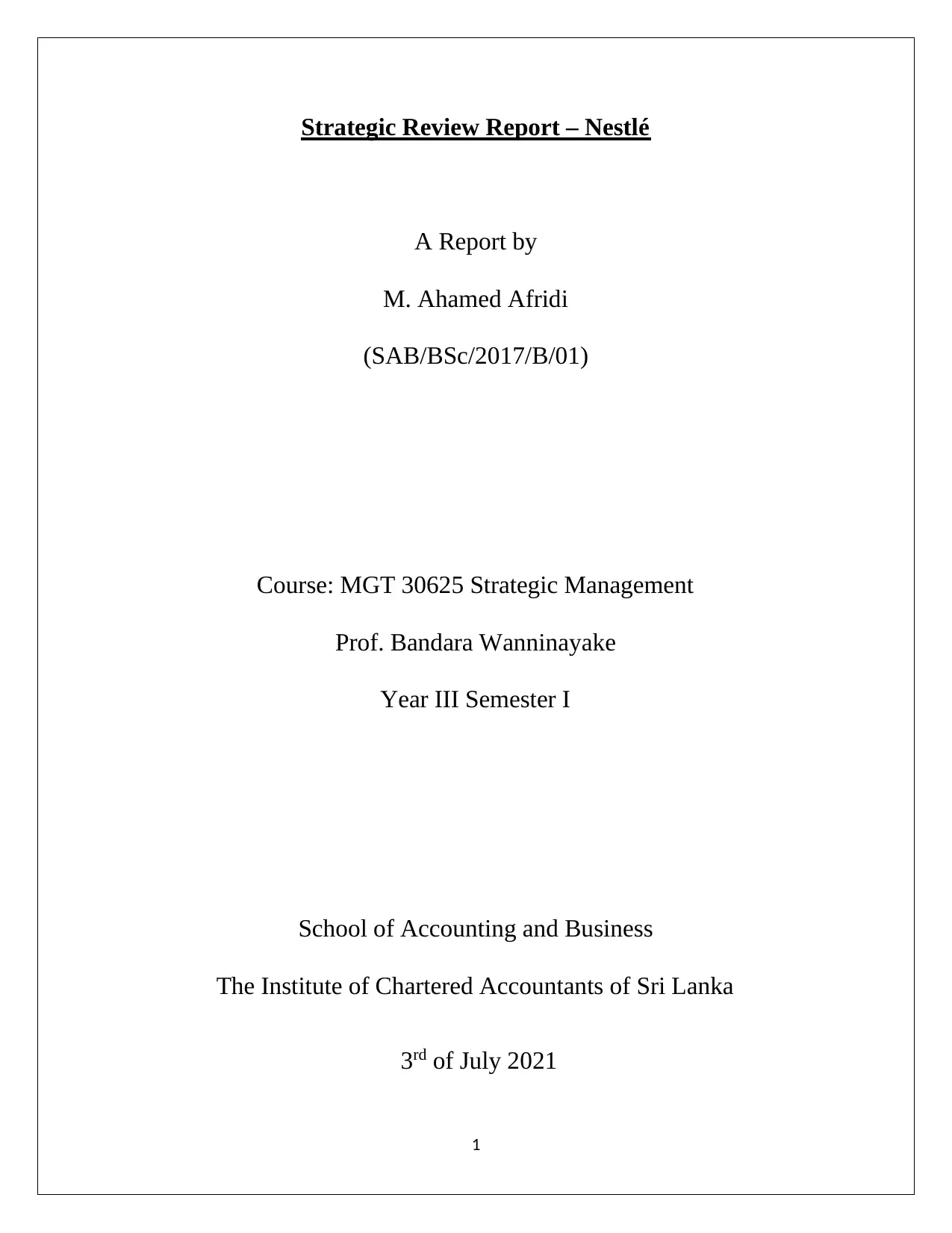
1
Strategic Review Report – Nestlé
A Report by
M. Ahamed Afridi
(SAB/BSc/2017/B/01)
Course: MGT 30625 Strategic Management
Prof. Bandara Wanninayake
Year III Semester I
School of Accounting and Business
The Institute of Chartered Accountants of Sri Lanka
3rd of July 2021
Strategic Review Report – Nestlé
A Report by
M. Ahamed Afridi
(SAB/BSc/2017/B/01)
Course: MGT 30625 Strategic Management
Prof. Bandara Wanninayake
Year III Semester I
School of Accounting and Business
The Institute of Chartered Accountants of Sri Lanka
3rd of July 2021
Paraphrase This Document
Need a fresh take? Get an instant paraphrase of this document with our AI Paraphraser
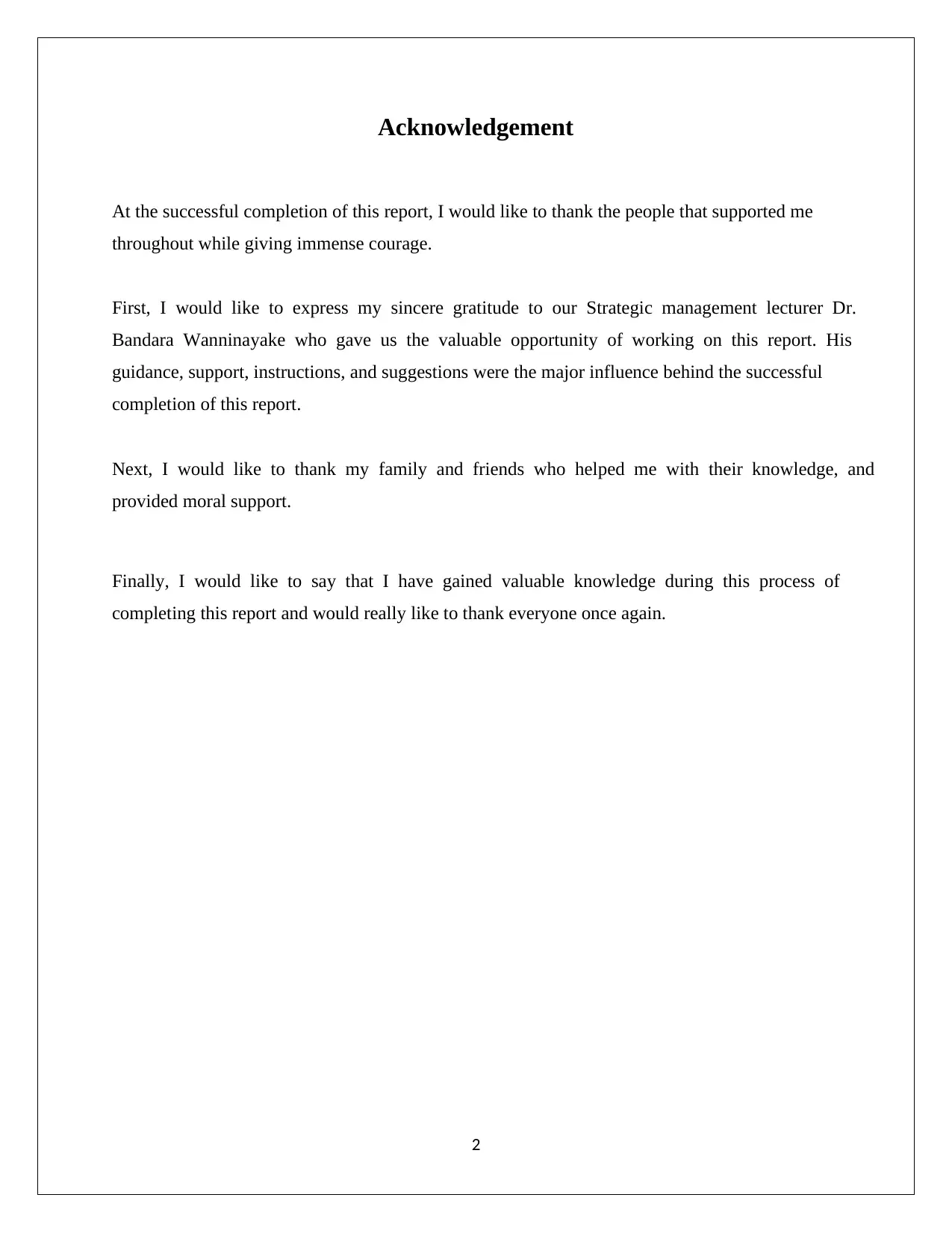
2
Acknowledgement
At the successful completion of this report, I would like to thank the people that supported me
throughout while giving immense courage.
First, I would like to express my sincere gratitude to our Strategic management lecturer Dr.
Bandara Wanninayake who gave us the valuable opportunity of working on this report. His
guidance, support, instructions, and suggestions were the major influence behind the successful
completion of this report.
Next, I would like to thank my family and friends who helped me with their knowledge, and
provided moral support.
Finally, I would like to say that I have gained valuable knowledge during this process of
completing this report and would really like to thank everyone once again.
Acknowledgement
At the successful completion of this report, I would like to thank the people that supported me
throughout while giving immense courage.
First, I would like to express my sincere gratitude to our Strategic management lecturer Dr.
Bandara Wanninayake who gave us the valuable opportunity of working on this report. His
guidance, support, instructions, and suggestions were the major influence behind the successful
completion of this report.
Next, I would like to thank my family and friends who helped me with their knowledge, and
provided moral support.
Finally, I would like to say that I have gained valuable knowledge during this process of
completing this report and would really like to thank everyone once again.
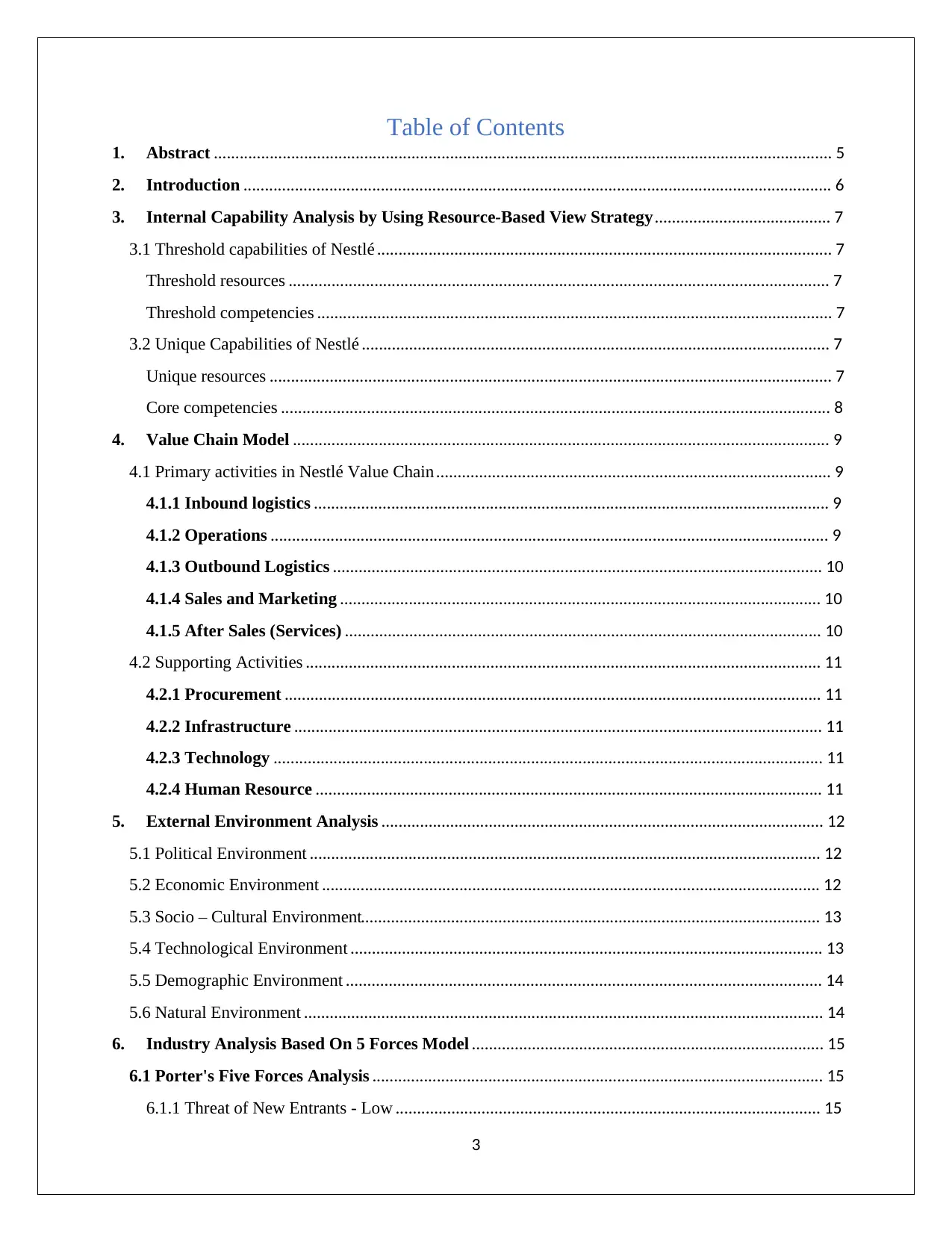
3
Table of Contents
1. Abstract ................................................................................................................................................ 5
2. Introduction ......................................................................................................................................... 6
3. Internal Capability Analysis by Using Resource-Based View Strategy ......................................... 7
3.1 Threshold capabilities of Nestlé .......................................................................................................... 7
Threshold resources .............................................................................................................................. 7
Threshold competencies ........................................................................................................................ 7
3.2 Unique Capabilities of Nestlé ............................................................................................................. 7
Unique resources ................................................................................................................................... 7
Core competencies ................................................................................................................................ 8
4. Value Chain Model ............................................................................................................................. 9
4.1 Primary activities in Nestlé Value Chain ............................................................................................ 9
4.1.1 Inbound logistics ........................................................................................................................ 9
4.1.2 Operations .................................................................................................................................. 9
4.1.3 Outbound Logistics .................................................................................................................. 10
4.1.4 Sales and Marketing ................................................................................................................ 10
4.1.5 After Sales (Services) ............................................................................................................... 10
4.2 Supporting Activities ........................................................................................................................ 11
4.2.1 Procurement ............................................................................................................................. 11
4.2.2 Infrastructure ........................................................................................................................... 11
4.2.3 Technology ................................................................................................................................ 11
4.2.4 Human Resource ...................................................................................................................... 11
5. External Environment Analysis ....................................................................................................... 12
5.1 Political Environment ....................................................................................................................... 12
5.2 Economic Environment .................................................................................................................... 12
5.3 Socio – Cultural Environment........................................................................................................... 13
5.4 Technological Environment .............................................................................................................. 13
5.5 Demographic Environment ............................................................................................................... 14
5.6 Natural Environment ......................................................................................................................... 14
6. Industry Analysis Based On 5 Forces Model .................................................................................. 15
6.1 Porter's Five Forces Analysis ......................................................................................................... 15
6.1.1 Threat of New Entrants - Low ................................................................................................... 15
Table of Contents
1. Abstract ................................................................................................................................................ 5
2. Introduction ......................................................................................................................................... 6
3. Internal Capability Analysis by Using Resource-Based View Strategy ......................................... 7
3.1 Threshold capabilities of Nestlé .......................................................................................................... 7
Threshold resources .............................................................................................................................. 7
Threshold competencies ........................................................................................................................ 7
3.2 Unique Capabilities of Nestlé ............................................................................................................. 7
Unique resources ................................................................................................................................... 7
Core competencies ................................................................................................................................ 8
4. Value Chain Model ............................................................................................................................. 9
4.1 Primary activities in Nestlé Value Chain ............................................................................................ 9
4.1.1 Inbound logistics ........................................................................................................................ 9
4.1.2 Operations .................................................................................................................................. 9
4.1.3 Outbound Logistics .................................................................................................................. 10
4.1.4 Sales and Marketing ................................................................................................................ 10
4.1.5 After Sales (Services) ............................................................................................................... 10
4.2 Supporting Activities ........................................................................................................................ 11
4.2.1 Procurement ............................................................................................................................. 11
4.2.2 Infrastructure ........................................................................................................................... 11
4.2.3 Technology ................................................................................................................................ 11
4.2.4 Human Resource ...................................................................................................................... 11
5. External Environment Analysis ....................................................................................................... 12
5.1 Political Environment ....................................................................................................................... 12
5.2 Economic Environment .................................................................................................................... 12
5.3 Socio – Cultural Environment........................................................................................................... 13
5.4 Technological Environment .............................................................................................................. 13
5.5 Demographic Environment ............................................................................................................... 14
5.6 Natural Environment ......................................................................................................................... 14
6. Industry Analysis Based On 5 Forces Model .................................................................................. 15
6.1 Porter's Five Forces Analysis ......................................................................................................... 15
6.1.1 Threat of New Entrants - Low ................................................................................................... 15
⊘ This is a preview!⊘
Do you want full access?
Subscribe today to unlock all pages.

Trusted by 1+ million students worldwide
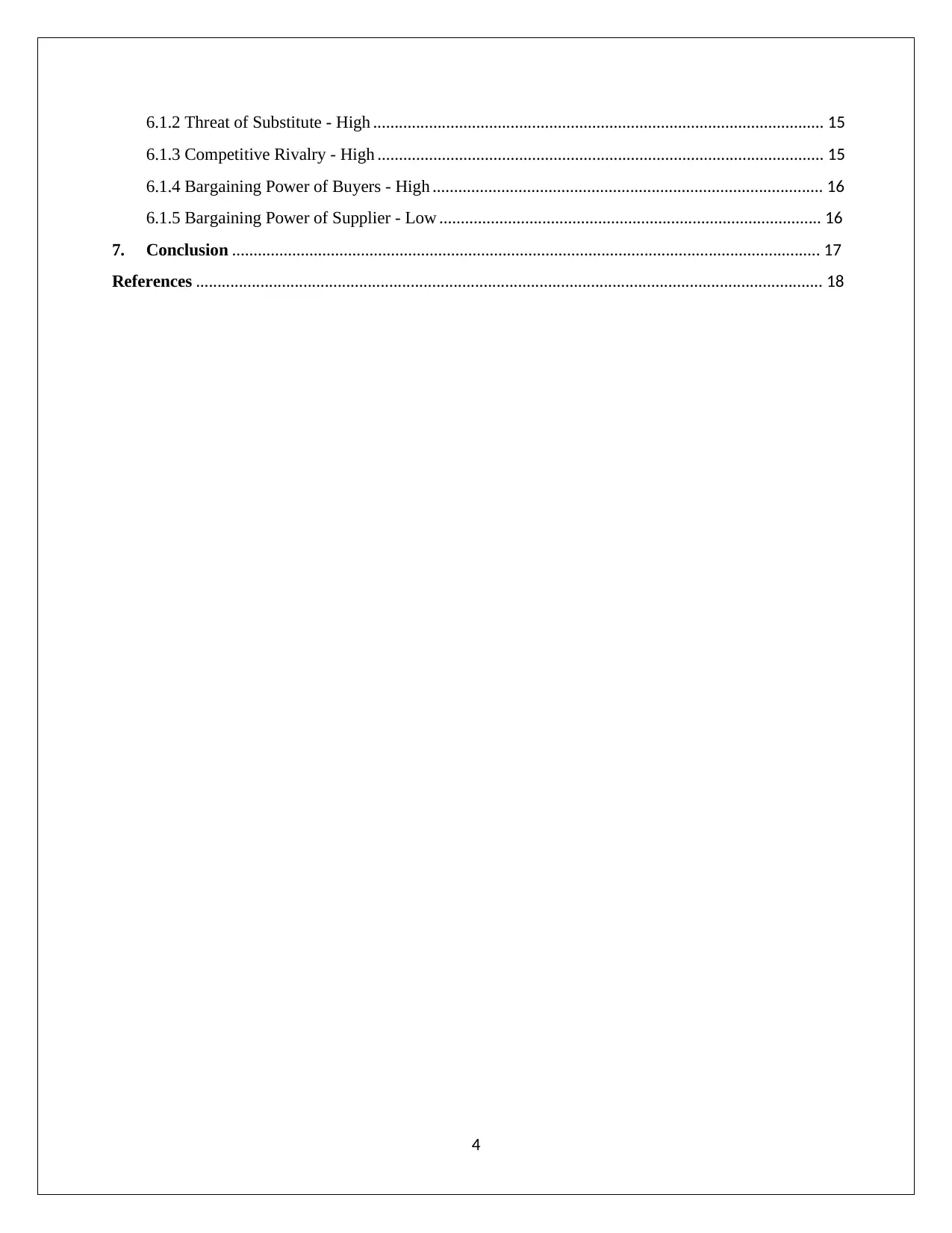
4
6.1.2 Threat of Substitute - High ......................................................................................................... 15
6.1.3 Competitive Rivalry - High ........................................................................................................ 15
6.1.4 Bargaining Power of Buyers - High ........................................................................................... 16
6.1.5 Bargaining Power of Supplier - Low ......................................................................................... 16
7. Conclusion ......................................................................................................................................... 17
References .................................................................................................................................................. 18
6.1.2 Threat of Substitute - High ......................................................................................................... 15
6.1.3 Competitive Rivalry - High ........................................................................................................ 15
6.1.4 Bargaining Power of Buyers - High ........................................................................................... 16
6.1.5 Bargaining Power of Supplier - Low ......................................................................................... 16
7. Conclusion ......................................................................................................................................... 17
References .................................................................................................................................................. 18
Paraphrase This Document
Need a fresh take? Get an instant paraphrase of this document with our AI Paraphraser
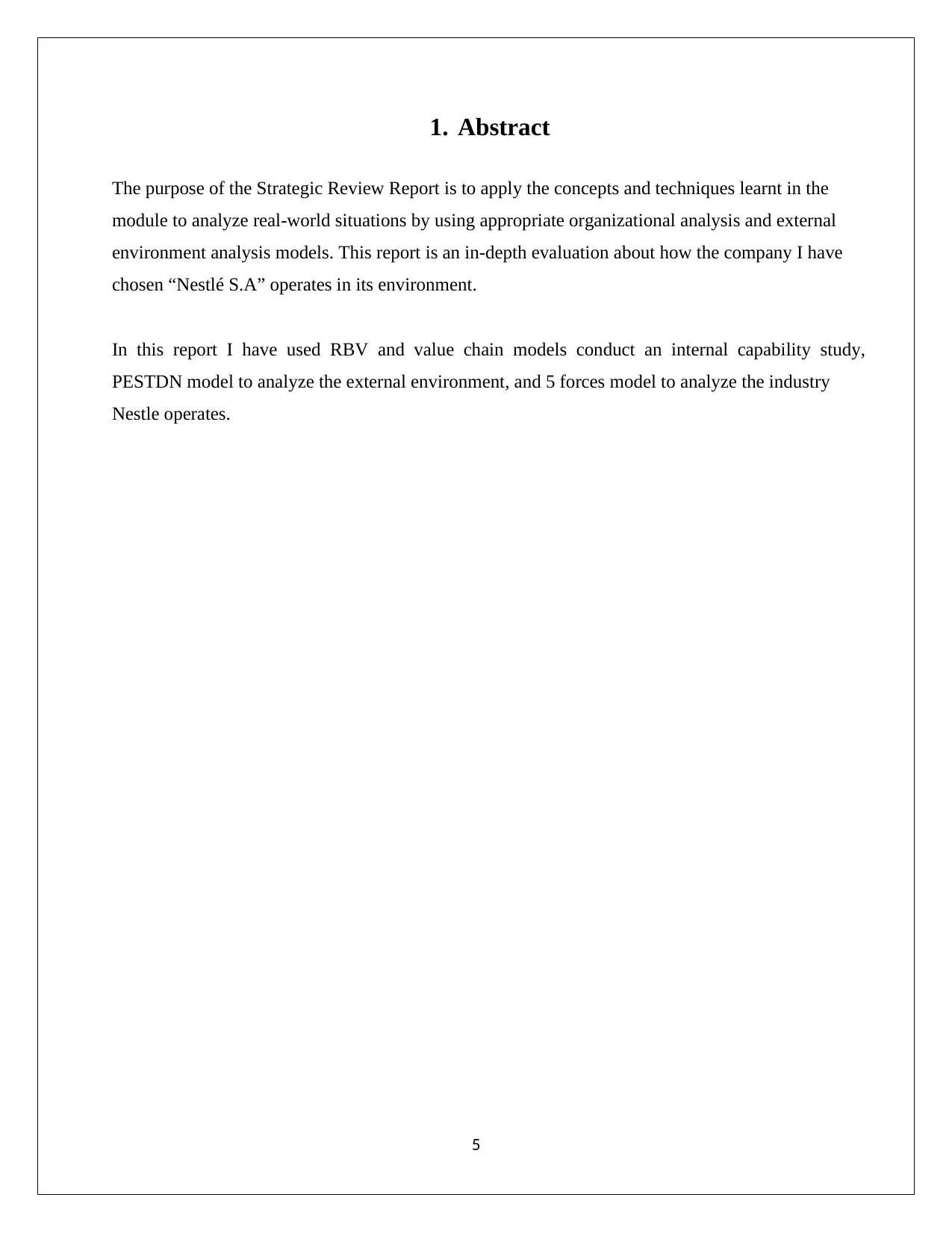
5
1. Abstract
The purpose of the Strategic Review Report is to apply the concepts and techniques learnt in the
module to analyze real-world situations by using appropriate organizational analysis and external
environment analysis models. This report is an in-depth evaluation about how the company I have
chosen “Nestlé S.A” operates in its environment.
In this report I have used RBV and value chain models conduct an internal capability study,
PESTDN model to analyze the external environment, and 5 forces model to analyze the industry
Nestle operates.
1. Abstract
The purpose of the Strategic Review Report is to apply the concepts and techniques learnt in the
module to analyze real-world situations by using appropriate organizational analysis and external
environment analysis models. This report is an in-depth evaluation about how the company I have
chosen “Nestlé S.A” operates in its environment.
In this report I have used RBV and value chain models conduct an internal capability study,
PESTDN model to analyze the external environment, and 5 forces model to analyze the industry
Nestle operates.
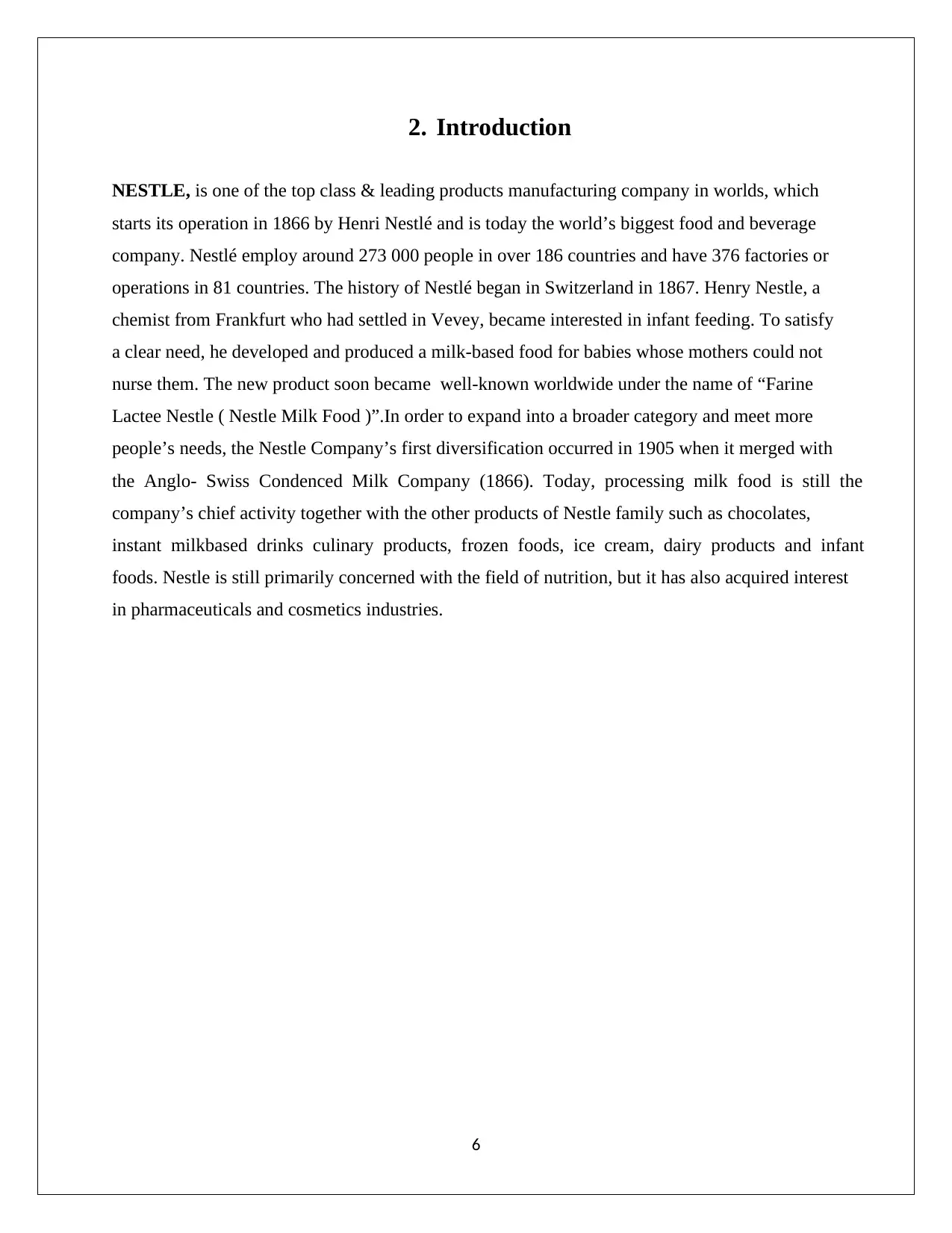
6
2. Introduction
NESTLE, is one of the top class & leading products manufacturing company in worlds, which
starts its operation in 1866 by Henri Nestlé and is today the world’s biggest food and beverage
company. Nestlé employ around 273 000 people in over 186 countries and have 376 factories or
operations in 81 countries. The history of Nestlé began in Switzerland in 1867. Henry Nestle, a
chemist from Frankfurt who had settled in Vevey, became interested in infant feeding. To satisfy
a clear need, he developed and produced a milk-based food for babies whose mothers could not
nurse them. The new product soon became well-known worldwide under the name of “Farine
Lactee Nestle ( Nestle Milk Food )”.In order to expand into a broader category and meet more
people’s needs, the Nestle Company’s first diversification occurred in 1905 when it merged with
the Anglo- Swiss Condenced Milk Company (1866). Today, processing milk food is still the
company’s chief activity together with the other products of Nestle family such as chocolates,
instant milkbased drinks culinary products, frozen foods, ice cream, dairy products and infant
foods. Nestle is still primarily concerned with the field of nutrition, but it has also acquired interest
in pharmaceuticals and cosmetics industries.
2. Introduction
NESTLE, is one of the top class & leading products manufacturing company in worlds, which
starts its operation in 1866 by Henri Nestlé and is today the world’s biggest food and beverage
company. Nestlé employ around 273 000 people in over 186 countries and have 376 factories or
operations in 81 countries. The history of Nestlé began in Switzerland in 1867. Henry Nestle, a
chemist from Frankfurt who had settled in Vevey, became interested in infant feeding. To satisfy
a clear need, he developed and produced a milk-based food for babies whose mothers could not
nurse them. The new product soon became well-known worldwide under the name of “Farine
Lactee Nestle ( Nestle Milk Food )”.In order to expand into a broader category and meet more
people’s needs, the Nestle Company’s first diversification occurred in 1905 when it merged with
the Anglo- Swiss Condenced Milk Company (1866). Today, processing milk food is still the
company’s chief activity together with the other products of Nestle family such as chocolates,
instant milkbased drinks culinary products, frozen foods, ice cream, dairy products and infant
foods. Nestle is still primarily concerned with the field of nutrition, but it has also acquired interest
in pharmaceuticals and cosmetics industries.
⊘ This is a preview!⊘
Do you want full access?
Subscribe today to unlock all pages.

Trusted by 1+ million students worldwide
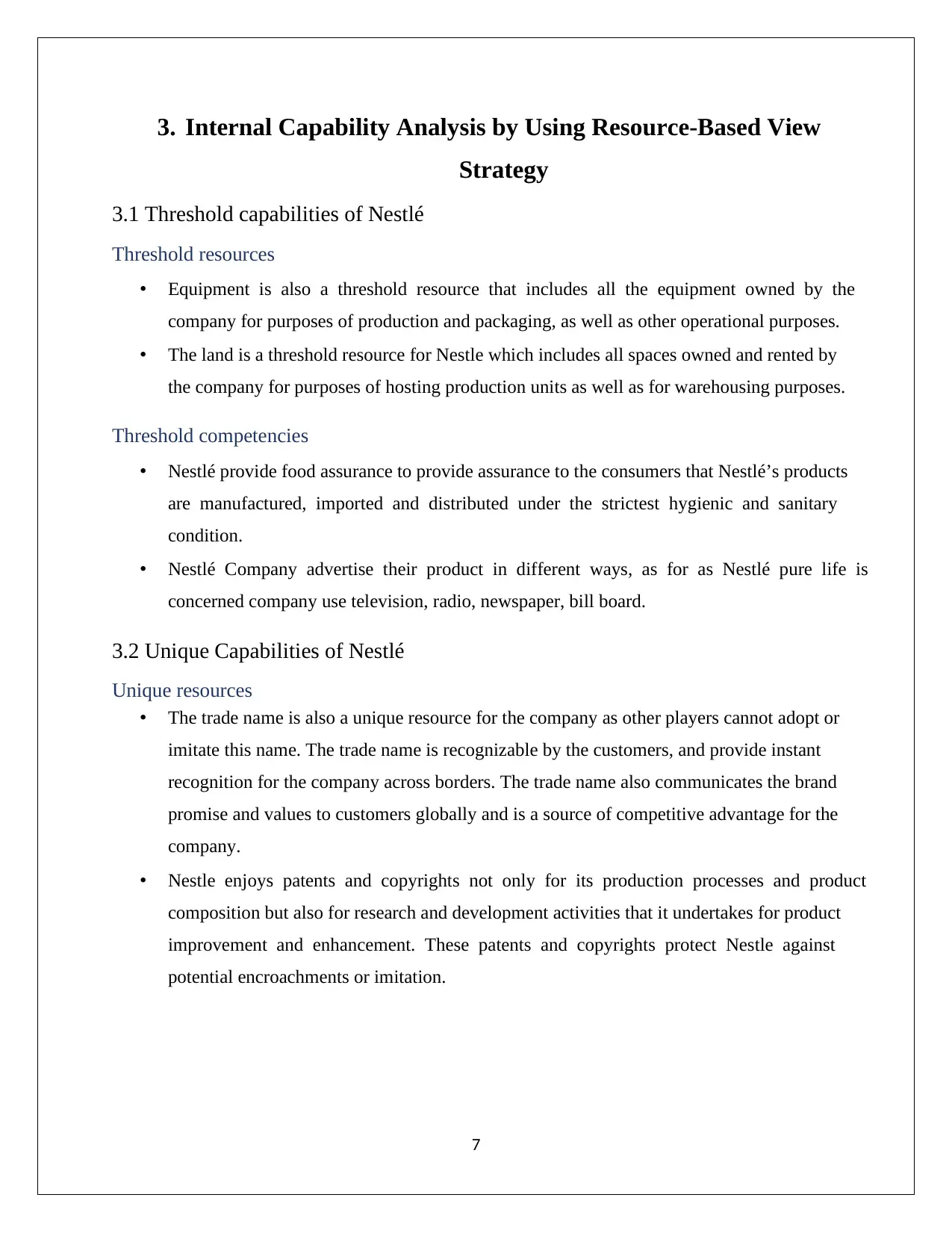
7
3. Internal Capability Analysis by Using Resource-Based View
Strategy
3.1 Threshold capabilities of Nestlé
Threshold resources
• Equipment is also a threshold resource that includes all the equipment owned by the
company for purposes of production and packaging, as well as other operational purposes.
• The land is a threshold resource for Nestle which includes all spaces owned and rented by
the company for purposes of hosting production units as well as for warehousing purposes.
Threshold competencies
• Nestlé provide food assurance to provide assurance to the consumers that Nestlé’s products
are manufactured, imported and distributed under the strictest hygienic and sanitary
condition.
• Nestlé Company advertise their product in different ways, as for as Nestlé pure life is
concerned company use television, radio, newspaper, bill board.
3.2 Unique Capabilities of Nestlé
Unique resources
• The trade name is also a unique resource for the company as other players cannot adopt or
imitate this name. The trade name is recognizable by the customers, and provide instant
recognition for the company across borders. The trade name also communicates the brand
promise and values to customers globally and is a source of competitive advantage for the
company.
• Nestle enjoys patents and copyrights not only for its production processes and product
composition but also for research and development activities that it undertakes for product
improvement and enhancement. These patents and copyrights protect Nestle against
potential encroachments or imitation.
3. Internal Capability Analysis by Using Resource-Based View
Strategy
3.1 Threshold capabilities of Nestlé
Threshold resources
• Equipment is also a threshold resource that includes all the equipment owned by the
company for purposes of production and packaging, as well as other operational purposes.
• The land is a threshold resource for Nestle which includes all spaces owned and rented by
the company for purposes of hosting production units as well as for warehousing purposes.
Threshold competencies
• Nestlé provide food assurance to provide assurance to the consumers that Nestlé’s products
are manufactured, imported and distributed under the strictest hygienic and sanitary
condition.
• Nestlé Company advertise their product in different ways, as for as Nestlé pure life is
concerned company use television, radio, newspaper, bill board.
3.2 Unique Capabilities of Nestlé
Unique resources
• The trade name is also a unique resource for the company as other players cannot adopt or
imitate this name. The trade name is recognizable by the customers, and provide instant
recognition for the company across borders. The trade name also communicates the brand
promise and values to customers globally and is a source of competitive advantage for the
company.
• Nestle enjoys patents and copyrights not only for its production processes and product
composition but also for research and development activities that it undertakes for product
improvement and enhancement. These patents and copyrights protect Nestle against
potential encroachments or imitation.
Paraphrase This Document
Need a fresh take? Get an instant paraphrase of this document with our AI Paraphraser
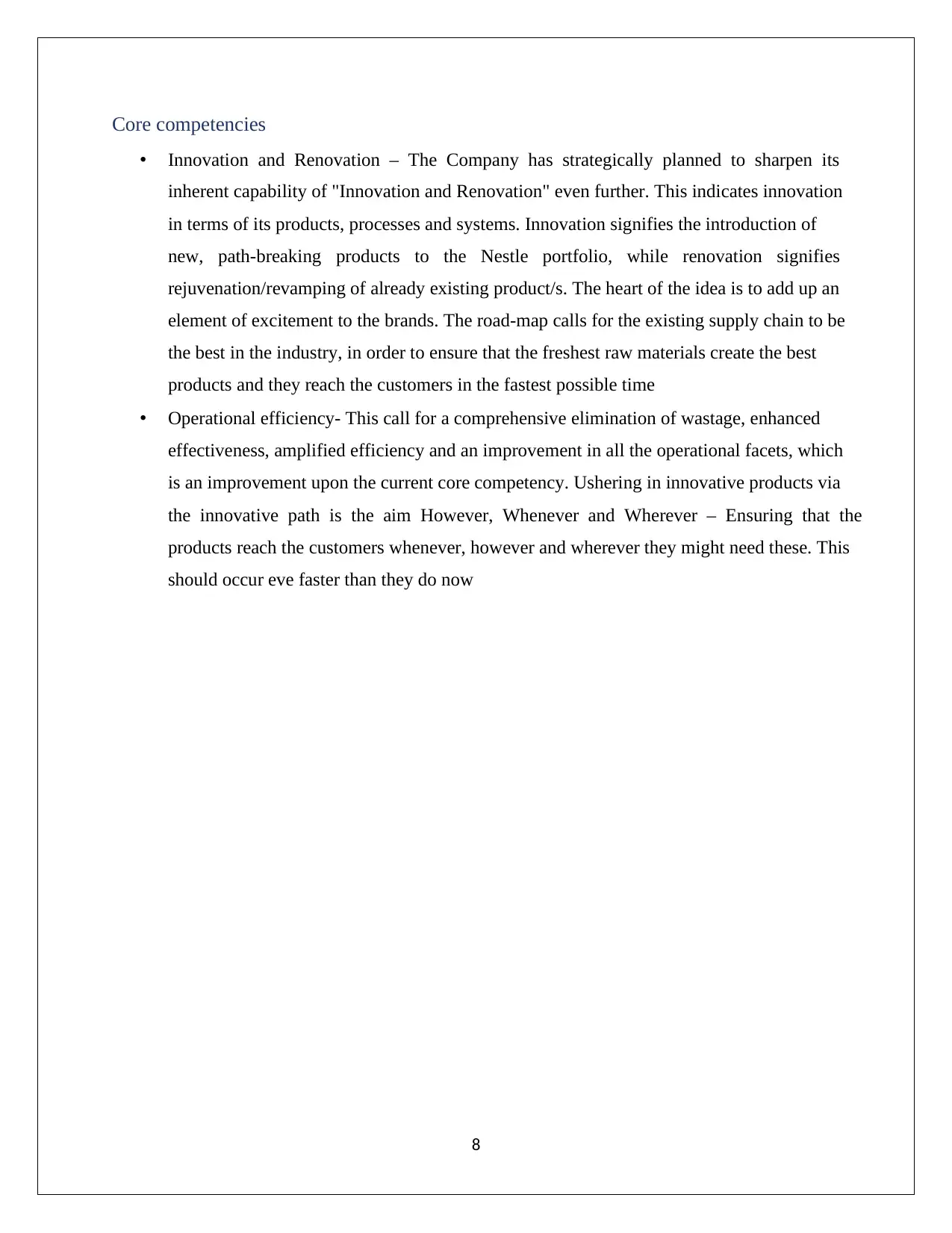
8
Core competencies
• Innovation and Renovation – The Company has strategically planned to sharpen its
inherent capability of "Innovation and Renovation" even further. This indicates innovation
in terms of its products, processes and systems. Innovation signifies the introduction of
new, path-breaking products to the Nestle portfolio, while renovation signifies
rejuvenation/revamping of already existing product/s. The heart of the idea is to add up an
element of excitement to the brands. The road-map calls for the existing supply chain to be
the best in the industry, in order to ensure that the freshest raw materials create the best
products and they reach the customers in the fastest possible time
• Operational efficiency- This call for a comprehensive elimination of wastage, enhanced
effectiveness, amplified efficiency and an improvement in all the operational facets, which
is an improvement upon the current core competency. Ushering in innovative products via
the innovative path is the aim However, Whenever and Wherever – Ensuring that the
products reach the customers whenever, however and wherever they might need these. This
should occur eve faster than they do now
Core competencies
• Innovation and Renovation – The Company has strategically planned to sharpen its
inherent capability of "Innovation and Renovation" even further. This indicates innovation
in terms of its products, processes and systems. Innovation signifies the introduction of
new, path-breaking products to the Nestle portfolio, while renovation signifies
rejuvenation/revamping of already existing product/s. The heart of the idea is to add up an
element of excitement to the brands. The road-map calls for the existing supply chain to be
the best in the industry, in order to ensure that the freshest raw materials create the best
products and they reach the customers in the fastest possible time
• Operational efficiency- This call for a comprehensive elimination of wastage, enhanced
effectiveness, amplified efficiency and an improvement in all the operational facets, which
is an improvement upon the current core competency. Ushering in innovative products via
the innovative path is the aim However, Whenever and Wherever – Ensuring that the
products reach the customers whenever, however and wherever they might need these. This
should occur eve faster than they do now
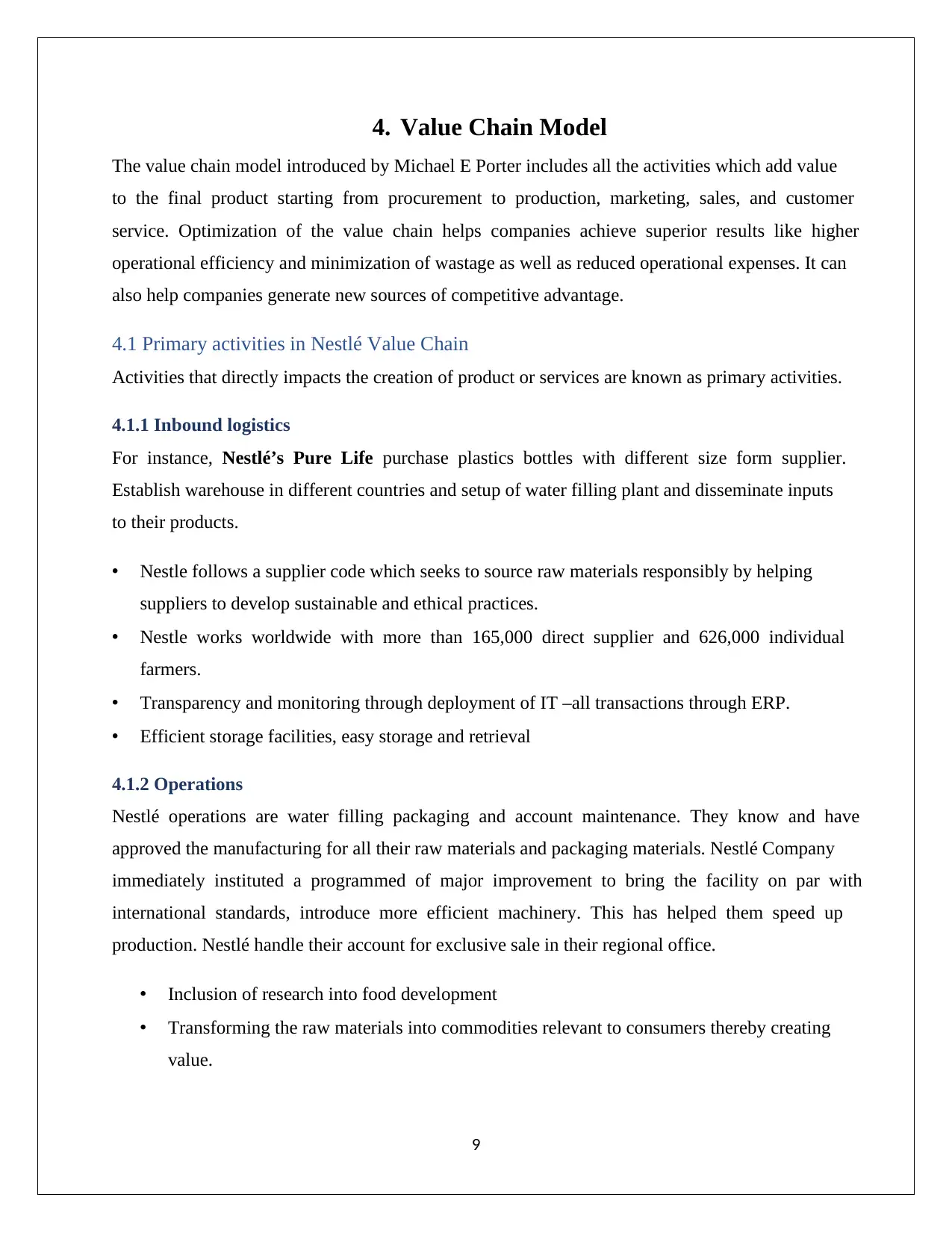
9
4. Value Chain Model
The value chain model introduced by Michael E Porter includes all the activities which add value
to the final product starting from procurement to production, marketing, sales, and customer
service. Optimization of the value chain helps companies achieve superior results like higher
operational efficiency and minimization of wastage as well as reduced operational expenses. It can
also help companies generate new sources of competitive advantage.
4.1 Primary activities in Nestlé Value Chain
Activities that directly impacts the creation of product or services are known as primary activities.
4.1.1 Inbound logistics
For instance, Nestlé’s Pure Life purchase plastics bottles with different size form supplier.
Establish warehouse in different countries and setup of water filling plant and disseminate inputs
to their products.
• Nestle follows a supplier code which seeks to source raw materials responsibly by helping
suppliers to develop sustainable and ethical practices.
• Nestle works worldwide with more than 165,000 direct supplier and 626,000 individual
farmers.
• Transparency and monitoring through deployment of IT –all transactions through ERP.
• Efficient storage facilities, easy storage and retrieval
4.1.2 Operations
Nestlé operations are water filling packaging and account maintenance. They know and have
approved the manufacturing for all their raw materials and packaging materials. Nestlé Company
immediately instituted a programmed of major improvement to bring the facility on par with
international standards, introduce more efficient machinery. This has helped them speed up
production. Nestlé handle their account for exclusive sale in their regional office.
• Inclusion of research into food development
• Transforming the raw materials into commodities relevant to consumers thereby creating
value.
4. Value Chain Model
The value chain model introduced by Michael E Porter includes all the activities which add value
to the final product starting from procurement to production, marketing, sales, and customer
service. Optimization of the value chain helps companies achieve superior results like higher
operational efficiency and minimization of wastage as well as reduced operational expenses. It can
also help companies generate new sources of competitive advantage.
4.1 Primary activities in Nestlé Value Chain
Activities that directly impacts the creation of product or services are known as primary activities.
4.1.1 Inbound logistics
For instance, Nestlé’s Pure Life purchase plastics bottles with different size form supplier.
Establish warehouse in different countries and setup of water filling plant and disseminate inputs
to their products.
• Nestle follows a supplier code which seeks to source raw materials responsibly by helping
suppliers to develop sustainable and ethical practices.
• Nestle works worldwide with more than 165,000 direct supplier and 626,000 individual
farmers.
• Transparency and monitoring through deployment of IT –all transactions through ERP.
• Efficient storage facilities, easy storage and retrieval
4.1.2 Operations
Nestlé operations are water filling packaging and account maintenance. They know and have
approved the manufacturing for all their raw materials and packaging materials. Nestlé Company
immediately instituted a programmed of major improvement to bring the facility on par with
international standards, introduce more efficient machinery. This has helped them speed up
production. Nestlé handle their account for exclusive sale in their regional office.
• Inclusion of research into food development
• Transforming the raw materials into commodities relevant to consumers thereby creating
value.
⊘ This is a preview!⊘
Do you want full access?
Subscribe today to unlock all pages.

Trusted by 1+ million students worldwide
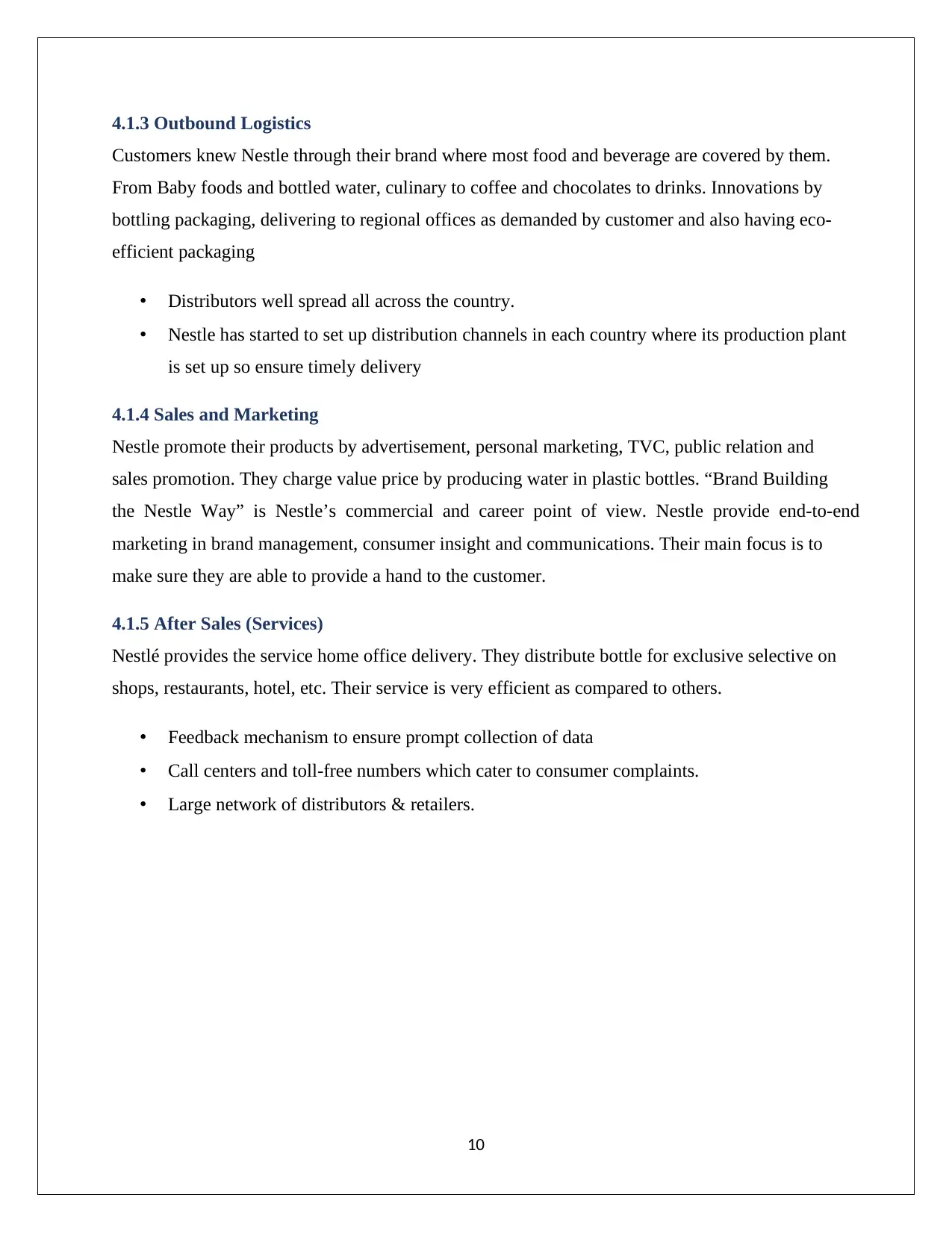
10
4.1.3 Outbound Logistics
Customers knew Nestle through their brand where most food and beverage are covered by them.
From Baby foods and bottled water, culinary to coffee and chocolates to drinks. Innovations by
bottling packaging, delivering to regional offices as demanded by customer and also having eco-
efficient packaging
• Distributors well spread all across the country.
• Nestle has started to set up distribution channels in each country where its production plant
is set up so ensure timely delivery
4.1.4 Sales and Marketing
Nestle promote their products by advertisement, personal marketing, TVC, public relation and
sales promotion. They charge value price by producing water in plastic bottles. “Brand Building
the Nestle Way” is Nestle’s commercial and career point of view. Nestle provide end-to-end
marketing in brand management, consumer insight and communications. Their main focus is to
make sure they are able to provide a hand to the customer.
4.1.5 After Sales (Services)
Nestlé provides the service home office delivery. They distribute bottle for exclusive selective on
shops, restaurants, hotel, etc. Their service is very efficient as compared to others.
• Feedback mechanism to ensure prompt collection of data
• Call centers and toll-free numbers which cater to consumer complaints.
• Large network of distributors & retailers.
4.1.3 Outbound Logistics
Customers knew Nestle through their brand where most food and beverage are covered by them.
From Baby foods and bottled water, culinary to coffee and chocolates to drinks. Innovations by
bottling packaging, delivering to regional offices as demanded by customer and also having eco-
efficient packaging
• Distributors well spread all across the country.
• Nestle has started to set up distribution channels in each country where its production plant
is set up so ensure timely delivery
4.1.4 Sales and Marketing
Nestle promote their products by advertisement, personal marketing, TVC, public relation and
sales promotion. They charge value price by producing water in plastic bottles. “Brand Building
the Nestle Way” is Nestle’s commercial and career point of view. Nestle provide end-to-end
marketing in brand management, consumer insight and communications. Their main focus is to
make sure they are able to provide a hand to the customer.
4.1.5 After Sales (Services)
Nestlé provides the service home office delivery. They distribute bottle for exclusive selective on
shops, restaurants, hotel, etc. Their service is very efficient as compared to others.
• Feedback mechanism to ensure prompt collection of data
• Call centers and toll-free numbers which cater to consumer complaints.
• Large network of distributors & retailers.
Paraphrase This Document
Need a fresh take? Get an instant paraphrase of this document with our AI Paraphraser
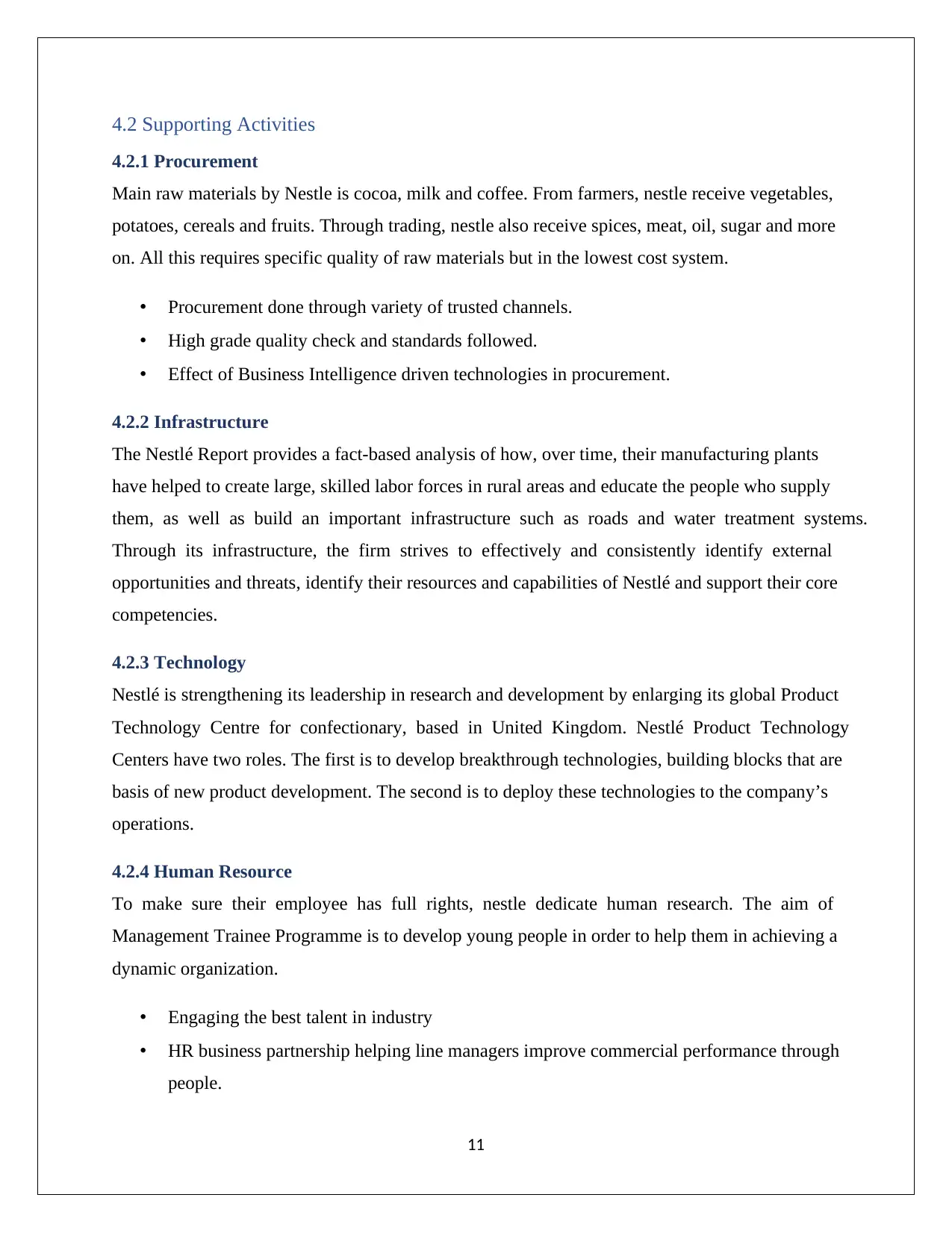
11
4.2 Supporting Activities
4.2.1 Procurement
Main raw materials by Nestle is cocoa, milk and coffee. From farmers, nestle receive vegetables,
potatoes, cereals and fruits. Through trading, nestle also receive spices, meat, oil, sugar and more
on. All this requires specific quality of raw materials but in the lowest cost system.
• Procurement done through variety of trusted channels.
• High grade quality check and standards followed.
• Effect of Business Intelligence driven technologies in procurement.
4.2.2 Infrastructure
The Nestlé Report provides a fact-based analysis of how, over time, their manufacturing plants
have helped to create large, skilled labor forces in rural areas and educate the people who supply
them, as well as build an important infrastructure such as roads and water treatment systems.
Through its infrastructure, the firm strives to effectively and consistently identify external
opportunities and threats, identify their resources and capabilities of Nestlé and support their core
competencies.
4.2.3 Technology
Nestlé is strengthening its leadership in research and development by enlarging its global Product
Technology Centre for confectionary, based in United Kingdom. Nestlé Product Technology
Centers have two roles. The first is to develop breakthrough technologies, building blocks that are
basis of new product development. The second is to deploy these technologies to the company’s
operations.
4.2.4 Human Resource
To make sure their employee has full rights, nestle dedicate human research. The aim of
Management Trainee Programme is to develop young people in order to help them in achieving a
dynamic organization.
• Engaging the best talent in industry
• HR business partnership helping line managers improve commercial performance through
people.
4.2 Supporting Activities
4.2.1 Procurement
Main raw materials by Nestle is cocoa, milk and coffee. From farmers, nestle receive vegetables,
potatoes, cereals and fruits. Through trading, nestle also receive spices, meat, oil, sugar and more
on. All this requires specific quality of raw materials but in the lowest cost system.
• Procurement done through variety of trusted channels.
• High grade quality check and standards followed.
• Effect of Business Intelligence driven technologies in procurement.
4.2.2 Infrastructure
The Nestlé Report provides a fact-based analysis of how, over time, their manufacturing plants
have helped to create large, skilled labor forces in rural areas and educate the people who supply
them, as well as build an important infrastructure such as roads and water treatment systems.
Through its infrastructure, the firm strives to effectively and consistently identify external
opportunities and threats, identify their resources and capabilities of Nestlé and support their core
competencies.
4.2.3 Technology
Nestlé is strengthening its leadership in research and development by enlarging its global Product
Technology Centre for confectionary, based in United Kingdom. Nestlé Product Technology
Centers have two roles. The first is to develop breakthrough technologies, building blocks that are
basis of new product development. The second is to deploy these technologies to the company’s
operations.
4.2.4 Human Resource
To make sure their employee has full rights, nestle dedicate human research. The aim of
Management Trainee Programme is to develop young people in order to help them in achieving a
dynamic organization.
• Engaging the best talent in industry
• HR business partnership helping line managers improve commercial performance through
people.
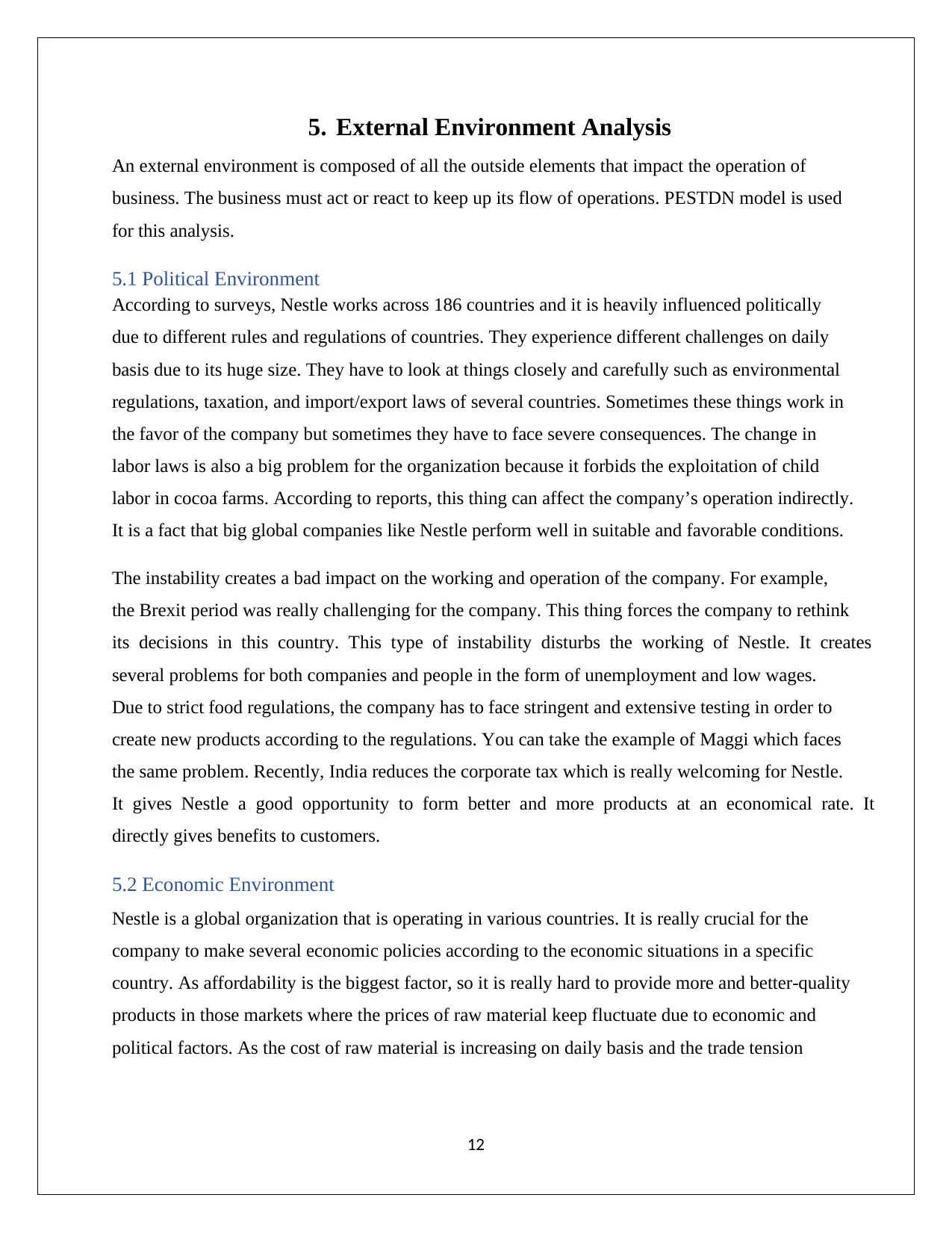
12
5. External Environment Analysis
An external environment is composed of all the outside elements that impact the operation of
business. The business must act or react to keep up its flow of operations. PESTDN model is used
for this analysis.
5.1 Political Environment
According to surveys, Nestle works across 186 countries and it is heavily influenced politically
due to different rules and regulations of countries. They experience different challenges on daily
basis due to its huge size. They have to look at things closely and carefully such as environmental
regulations, taxation, and import/export laws of several countries. Sometimes these things work in
the favor of the company but sometimes they have to face severe consequences. The change in
labor laws is also a big problem for the organization because it forbids the exploitation of child
labor in cocoa farms. According to reports, this thing can affect the company’s operation indirectly.
It is a fact that big global companies like Nestle perform well in suitable and favorable conditions.
The instability creates a bad impact on the working and operation of the company. For example,
the Brexit period was really challenging for the company. This thing forces the company to rethink
its decisions in this country. This type of instability disturbs the working of Nestle. It creates
several problems for both companies and people in the form of unemployment and low wages.
Due to strict food regulations, the company has to face stringent and extensive testing in order to
create new products according to the regulations. You can take the example of Maggi which faces
the same problem. Recently, India reduces the corporate tax which is really welcoming for Nestle.
It gives Nestle a good opportunity to form better and more products at an economical rate. It
directly gives benefits to customers.
5.2 Economic Environment
Nestle is a global organization that is operating in various countries. It is really crucial for the
company to make several economic policies according to the economic situations in a specific
country. As affordability is the biggest factor, so it is really hard to provide more and better-quality
products in those markets where the prices of raw material keep fluctuate due to economic and
political factors. As the cost of raw material is increasing on daily basis and the trade tension
5. External Environment Analysis
An external environment is composed of all the outside elements that impact the operation of
business. The business must act or react to keep up its flow of operations. PESTDN model is used
for this analysis.
5.1 Political Environment
According to surveys, Nestle works across 186 countries and it is heavily influenced politically
due to different rules and regulations of countries. They experience different challenges on daily
basis due to its huge size. They have to look at things closely and carefully such as environmental
regulations, taxation, and import/export laws of several countries. Sometimes these things work in
the favor of the company but sometimes they have to face severe consequences. The change in
labor laws is also a big problem for the organization because it forbids the exploitation of child
labor in cocoa farms. According to reports, this thing can affect the company’s operation indirectly.
It is a fact that big global companies like Nestle perform well in suitable and favorable conditions.
The instability creates a bad impact on the working and operation of the company. For example,
the Brexit period was really challenging for the company. This thing forces the company to rethink
its decisions in this country. This type of instability disturbs the working of Nestle. It creates
several problems for both companies and people in the form of unemployment and low wages.
Due to strict food regulations, the company has to face stringent and extensive testing in order to
create new products according to the regulations. You can take the example of Maggi which faces
the same problem. Recently, India reduces the corporate tax which is really welcoming for Nestle.
It gives Nestle a good opportunity to form better and more products at an economical rate. It
directly gives benefits to customers.
5.2 Economic Environment
Nestle is a global organization that is operating in various countries. It is really crucial for the
company to make several economic policies according to the economic situations in a specific
country. As affordability is the biggest factor, so it is really hard to provide more and better-quality
products in those markets where the prices of raw material keep fluctuate due to economic and
political factors. As the cost of raw material is increasing on daily basis and the trade tension
⊘ This is a preview!⊘
Do you want full access?
Subscribe today to unlock all pages.

Trusted by 1+ million students worldwide
1 out of 18
Related Documents
Your All-in-One AI-Powered Toolkit for Academic Success.
+13062052269
info@desklib.com
Available 24*7 on WhatsApp / Email
![[object Object]](/_next/static/media/star-bottom.7253800d.svg)
Unlock your academic potential
Copyright © 2020–2025 A2Z Services. All Rights Reserved. Developed and managed by ZUCOL.




